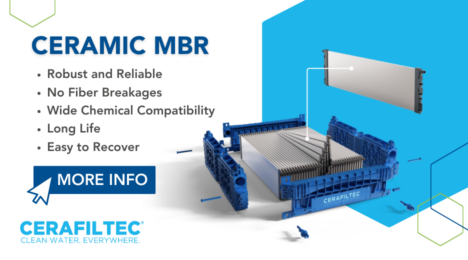Climate change challenges in wastewater management

Simon Judd has over 35 years’ post-doctorate experience in all aspects of water and wastewater treatment technology, both in academic and industrial R&D. He has (co-)authored six book titles and over 200 peer-reviewed publications in water and wastewater treatment.
Mrs J and myself had the pleasure of attending a workshop on Wet Weather Overflows at this year’s WEFTEC in New Orleans, the latest in Ovivo’s 'Utilities Of The Future' series (stretching back many years). It was a thought-provoking session, with some compelling observations from the assembled panel. It also served to allow me to dwell upon, not for the first time, the subject of climate change.

To the water research community, there are basically two strands of climate change research: modelling and adaptation. Modelling attempts to try and predict the impact of climate change on meteorological events. Adaptation takes this information, often the worst case scenario, and identifies what corrective or remedial measures can be taken to limit the impact of these events.
As far as the water utilities are concerned, the challenges are very simple: too much water during wet weather events and too little of it during droughts.
Prolonged droughts are very obviously of huge concern. Pretty much every time the rains fail and/or the reservoirs get dangerously low, there is a reappraisal of water recycling − 'toilet to tap'. This extreme solution is currently only intentionally practised in two regions of the world: Windhoek in Namibia, and in Singapore. The Singaporeans have been trailblazers in this regard, managing the considerable public perception issues quite masterfully by branding the recovered water 'Newater'. Membrane technology, and MBRs in particular, play a pivotal role in water reuse since the highest treated water quality is required.
However, while it may not be obvious to Joe and Josephine Public, too much water also presents its own challenges. All wastewater treatment works are designed to treat only a certain maximum volumetric flow rate of water, the so-called peak or full flow. Problems arise when the flows exceed the design limit of the works.
High flows are almost always associated with rainfall. For intense rainfall in short periods combined sewer systems − ones treating both waste and storm waters − can simply be overrun, resulting in overflows (hence 'combined sewer overflows' or CSOs). The end result of this is the contamination of the discharged water with sewage, and specifically with suspended solids and pathogenic bacteria.
What is interesting in all of this is that for both extremes of too little and too much water, the corrective measures for addressing the challenges are ultimately governed by the same parameters: cost and risk.
For extreme drought conditions, once all demand management options (hosepipe bans, low-flush toilets, tariffs, etc) have been applied, water recycling becomes an imperative. The emphasis then is on managing the risk and, generally speaking, reducing the risk demands spending more money. Inevitably, the law of diminishing returns applies: a point is reached where spending oodles more cash provides only a relatively minor improvement in water quality. And that improvement only marginally impacts on human health.
For wet weather flows, the simplest option is to build bigger systems to cope with the more extreme flows. However, the capital cost of this can be huge. The same balance of risk applies, and a decision has to be made as to whether the capital investment is justified given the likelihood of the event.
And it’s not just about the money. The impact of large capital projects can be measured in their associated footprint, the embedded carbon of the materials and construction, or other environmental impact metrics.
So who decides? Well, these things are normally dictated by the required water quality, which then comes down to the regulators. And the regulators have to be pragmatic. It’s fine to stipulate that discharged or reused water has to meet the highest standards possible, but there clearly has to be a line drawn somewhere: there’s no justification, for example, for generating ultrapure water − the stuff associated with pharmaceutical or microprocessor manufacture.
Which then leads to the questions: where exactly do you draw the line, and on what basis? And is there even enough information to make this assessment? The answer is 'yes, sort of'. Risks can be estimated based on historical information, but predicting the extent of future extreme weather events relies on accurate climate change modelling. So, there’s a strong element of educated guesswork in all of this.
What's more, the balance of investment against risk of negative impacts to the environmental and/or health tends to take second place to public perception, as made abundantly clear by the two municipality representatives at the workshop. The general public, by and large, will not accept toilet-to-tap recycling under any circumstances, and are also not slow to berate the utilities when there is a breach of discharged water quality standards during extreme rainfall events.
Yet this is the same general public who are (a) generally unwilling to part with their cash for a reliably clean potable water supply or properly managed wastewater, (b) as unwilling to use tap water for drinking directly, preferring instead to purchase bottled water in PET containers which have limited recycling opportunities such that a large proportion ends up being landfilled and/or slowly accumulates in the oceans, and (c) use their toilet and sinks as a waste disposal units, causing significant operational problems for the water utilities. And, of course, a low carbon footprint existence is beyond the pale for most people: even surviving without having electronic appliances on standby represents too big a challenge.
So, actual risk is apparently less important than perceived risk. And yet the actual risks to overall global sustainability imposed by climate change are devastatingly huge compared to the tiny risks to the environment or human health associated with either water reuse or ephemeral storm flows.
Maybe something to think about next time we buy bottled water instead of just taking it from the tap.









